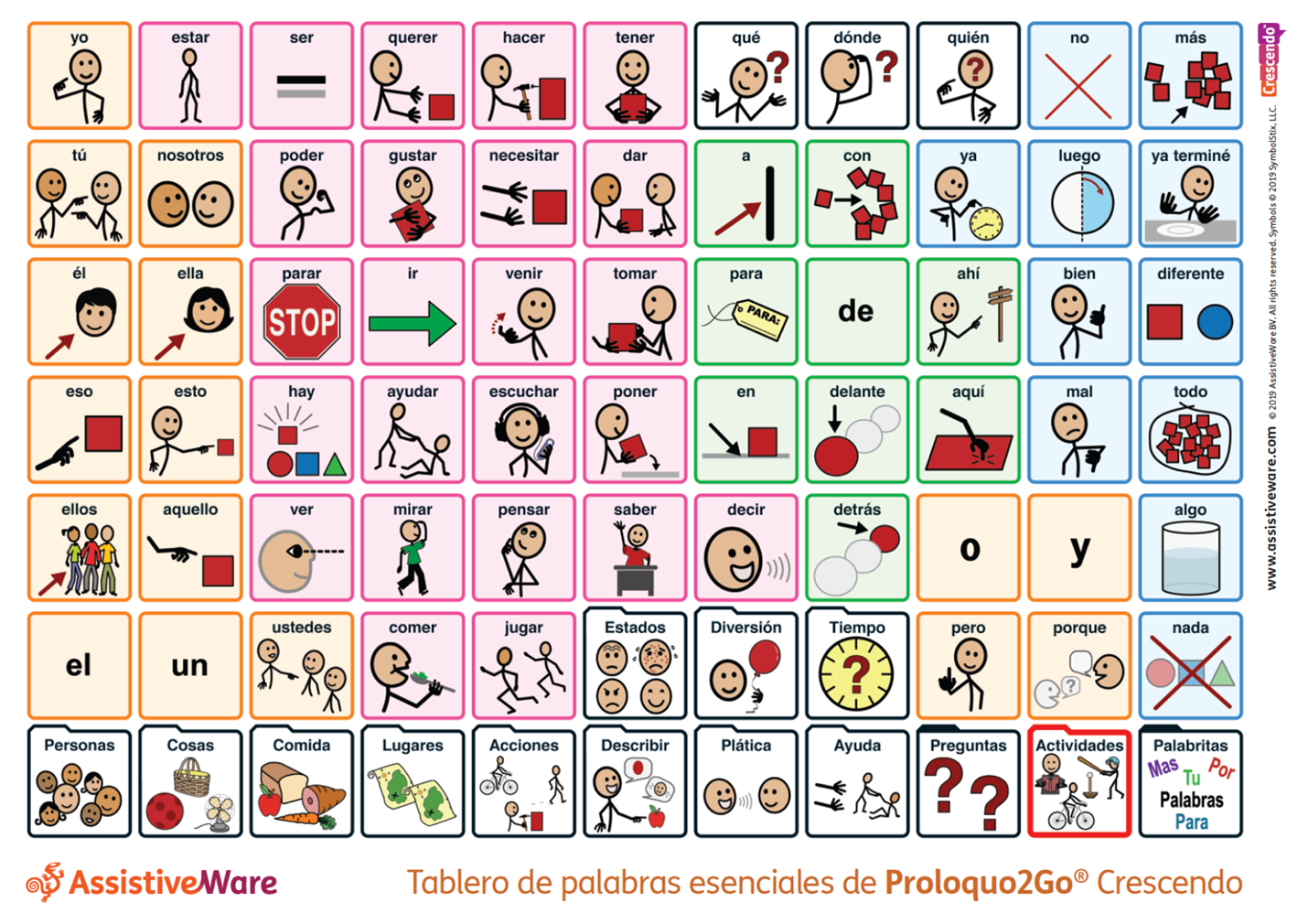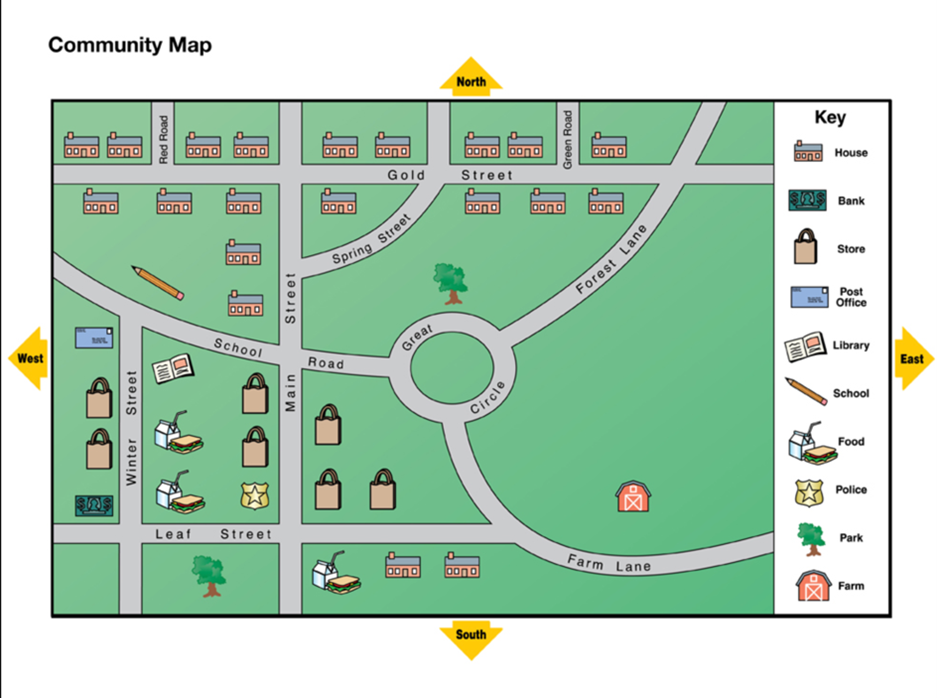Dónde y Adónde/Where?
Dónde is used when asking for location of person, place or thing; Adónde is used when asking for destination.
Ways We Can use The Word(s)
Dónde = Location
ASK LOCATION OF PEOPLE: e.g., ¿Dónde está + singular noun? (Where is Daddy? or Where is Mommy?) or ¿Dónde están mis amigos? (Where are my friends?)
ASK LOCATION OF PLACE: e.g., ¿Dónde es su casa? (Where is your home?)
ASK LOCATION OF OBJECT OR OBJECTS: e.g., ¿Dónde está mi libro? (Where is my book?) or ¿Dónde están + plural noun? (Where are my blocks?)
Adónde = Destination
ASK DESTINATION OF PERSON: e.g., ¿Adónde vas? (Where are you going?);¿Adónde fuiste? (Where did you go?); ¿Adónde quieres ir? (Where do you want to go?)
For specific questions or more ideas regarding this core word Activity Sheet, please contact Nancy Robinson @ nancyr@sfsu.edu Gracias!
Snack/mealtimes: During mealtime or snack time, the adult can initially model questions and then request students to ask locations of different food items, such as “¿Dónde está el jugo?, ¿Dónde está una galleta para ti?, ¿Dónde está el queso?. “ (Where is the juice?, Where is a cookie for you?, Where is the cheese?)
*Circle: During morning circle, the adults can ask students to take turns leading attendance and prompt the student to take attendance and to ask “ ¿Dónde está Anita?, ¿Dónde está Samuel?, ¿Dónde está Ricky?” (Where is Anita?, Where is Samuel?, Where is Ricky?), etc. *See Activity Sheet for Aquí and combine Attendance with each student called upon to say, “Estoy aquí” (I am here) in response.
Activity Centers: During activity centers such as Art, Music, Dress-Up, etc. the adult can model questions with Dónde to ask “¿Dónde están las crayolas?, ¿Dónde está la tambourine?, ¿Dónde está el sombreo de pirata?” (Where are the crayons?, Where is the tambourine?, Where is the pirate hat?), etc.
Recess: While playing “hide and seek,” the adult and peers can model the word donde in various ways, such as: “¿Dónde pueden estar escondidos?” (Where could they be hiding?) while trying to find the people or the object that is hiding. “Me pregunto donde están” (I wonder where they are), “¿Dónde está xxx? This could be a question the adult shouts out to the children who are hiding.
Toys and Games: “¿Dónde está el/la xx?” In this game, the adult or a peer hides a toy somewhere in the room and the focus child has to use “donde” to describe its location. “¿Dónde busco?” (where do I look for?) Is a simple game available in arasaac.org where the child has to match objects to the place they belong (e.g. clothes go in the closet). Same game can be played with animals, eg., “¿Dónde vive la jirafa?” (where does the giraffe live?)
Here are some suggested books on YouTube in Spanish that can assist in teaching the core words, dónde and adónde.
- ¿De dónde eres? |Author, Yamile Saied Méndez | Illustrator, Jaime Kim| Read by Dolma Diaz-Arellano
- The story is about a young girl who does not know how to answer the question, “Where are you from?” Her grandfather tells her what her roots are, touching on themes of identity and belonging.
- ¿Dónde Vivan?: Produced by Casita Preescolar| Children's Book Read Aloud by Profra. Maria Elena C.
- Video for children from 3 to 5 years old about the 6 animal habitats (Desert, Savannah, Coast, Forest, Jungle and Sea) with a multiple choice game.
- Dónde viven los monstruos (Where the Wild Things Are) |Author and Illustrator, Maurice Sendak |Read by Mrs. F.
- The story of Max, who escapes to an island where he on an island where he meets mysterious and strange creatures whose emotions are as wild and unpredictable as their actions.
Here are some suggested Spanish/English Bilingual books on YouTube that can assist in teaching the core word:
- ¿Dónde Esta El Chavo? (Where is El Chavo?) |Authors Patty Rodriquez and Ariana Stein |Read by Mario |Really Awesome Books
- This short book is read in Spanish and shows English text in the book and introduces preposition concepts where El Chavo is hiding. By pausing the story, adults can prompt guesses of dónde (where) El Chavo is.
- ¿Dónde esta Spot? (Where's Spot?) |Bilingual books read aloud in Spanish & English| Spanish stories for kids |Spanish.club4kids
- Children's story read aloud into Spanish and English, providing practice for learning prepositions with animals and places in the house.
When returning from a weekend or holiday break, adults ask the question, ¿Adónde fuiste? (Where did you go?) and start conversations with students about places and activities. Using Aided Language Stimulation, adults can model the question on individual student’s AAC systems to ask peers the same question and responses about weekend or break locations and activities.
Here is a sample Spanish core vocabulary communication layout, free and downloadable from AssistiveWare which provides access to a diverse variety of words, with question words including dónde (where).

Find the noisy toy game: Find a noisy toy such as a music box, buzzer, alarm clock, etc. and adults hide in one of set of three large boxes, labeled !, 2 o 3 in various locations in the classroom. Ask, “¿Dónde está musica?” (Where is the music?) or [name other noisemaking object] that is hidden. Students guess which box by number. Next, each student can have a turn hiding or assistance hiding the noisy toy and ask the class, “¿Dónde está [el nombre del objeto]?”. (Where is the [name of object]?)
Find the toy. Adults can show a toy (animal, vehicle, etc.) to the students and ask them to close their eyes while hiding nearby. Ask, “¿Dónde está [el nombre del jugete]?” (Where is the [name of toy]?)Next, each student can have a turn hiding or assistance hiding the toy and ask the class, “¿Dónde está [el nombre del jugete]?” (Where is the [name of toy]?)
Literacy-Building Activity: Create a story about ¿Dónde vivo? (Where I live, my community, my neighborhood). You can also create a book “Donde viven los animales,” to describe where animals live. For example: El oso polar vive en el Artico, donde hace mucho frío” (The polar bear lives in the Artic, where it is very cold.”
- Pañuelito, ¿dónde esta? (Little Handkerchief, where are you?) | Calico Spanish for Kids
- Fun Spanish children's song for introducing prepositions of location.
- Dónde|Palabras de uso frecuente (High frequency words)
- Kindergarten sight word song, teaching dónde. The printed word is used in sentences and in a short game to identify the word.
- ¿Adónde Vas? | Lugares para Niños (Places in Spanish for Kids) | Mi Camino Spanish
- This song teaches how to answer Where questions: Where are you going, Where did you go today? and Where will you go today?
- ¿Adónde Vas? | wh-questions in Spanish |Rockalingua
- Learn how to formulate basic questions in Spanish with fun and catchy song.
Art Activity: The adult can ask students, “¿Dónde está tu lugar feliz?” (Where is your happy place?) and show pictures of possible places that make each student happy, such a room at home, the playground, the zoo, the beach, ice cream store, garden, library. Ask students to think of a happy place and then select a picture or draw a picture of their happy place. Encourage each student to ask others, “¿Dónde está tu lugar feliz?” and to show each other their pictures and drawings while naming their happy place. Display pictures in the classroom of students’ happy places.
Geography Activity: Building on the above activity, the adult can ask students about the Happy Places they chose and posted on the wall, “¿Adónde quieres ir?” (Where do you want to go?) and encourage students to ask each other that same question. An extension of this activity could be in a geography lesson with a fictional, large map of the neighborhood with photos of places in the area. The adult can ask students, “¿Dónde está el parque?, ¿Dónde está el parque?, ¿Dónde está la tienda de mascotas?”, etc. and wait for students to respond using individual communication modalities.

Community Map Example Courtesy of National Geographic Learning/Cengage Learning
Also see Teachers Pay Teachers: Giving Directions in Spanish Map Activity
Science Activity: When teaching about weather, adults can use You Tube videos in Spanish to introduce where rain comes from with the following video: ¿De dónde viene la lluvia? By Veduk.com. The video is in Spanish and subtitles can be enabled in English. Following the video, students can make a rain cloud in a jar with simple materials, including a jar, water, shaving cream and blue food coloring in a dropper. Easy demonstration is shown without words in this You Tube video: Nube de lluvia en un frasco/ Rain Cloud in a Jar by Julia Moskowitz.
The Educational APP Store includes reviews of APPS for children in Spanish. Two of the many APPS reviewed include: Spanish Safari - Game for Kids which is described as “a stylish and well-presented interactive app Spanish Safari aimed at young children. It boasts a wide variety of interactive games to help your child take their first steps on their Spanish-language learning journey.” Also included is DinoLingo: Languages for kids, described as, “the best language learning app & website for kids. You can learn Spanish through online games, videos, songs, books, posters, flashcards and worksheets.”
WORD WALL: Create a Word Wall and add dónde and adónde to the list.
READING and the Word Wall: Sound out the letters together. Have the students find the word on the AAC system.
WRITING and the Word Wall: Using a pencil or alternative pencil, have students try to type the word on the keyboard, adapted keyboard or write the word together.
Courtesy of Edmonton Regional Learning Consortium.